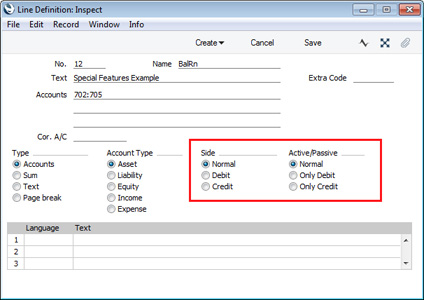Balance Sheet - Special Features
This web page describes the Side and Active/Passive options in the
Balance Sheet line definitions.

You can use these options to satisfy certain accounting and reporting requirements in various countries. The easiest way to describe these options is with the help of an example. In most companies, there are a number of reconciliation or suspense accounts, either assets or liabilities, which alternately can hold debit or credit balances. The accounting conventions of some countries only allow "pure" debit or credit accounts, and when a balance sheet is produced, it becomes necessary to move individual accounts back and forth between the active or the passive groups, depending on the current positive or negative balance.
To complicate things even further, in some countries it is customary to distinguish between four different "states" of a book entry: Debit+, Debit-, Credit+ and Credit-. In modern western accounting systems, a book entry is either debit or credit, regardless of the class of the account, i.e. there is a simple arithmetic definition of balances.
In those environments where all these special rules are used, the preparation of balance reports tends to become complicated and labour consuming. These special functions in Standard ERP allow the far-reaching automation of many of these routine tasks. This is how it works.
Let us start with the following Nominal Ledger reports, showing the postings made to four Asset Accounts.
- Account 702 has a normal debit balance. Two negative values have been posted, one as a debit and one as a credit:

- Account 703 currently has a balance in credit. The debit total for this Account for the period is 15.00, and the credit total 4000.00:

- Account 704 has an overall credit balance because of a large negative debit posting:

- Account 705 has an overall debit balance because of a large negative credit posting:

If the Accounts are used in a report definition in the normal way and with the Side:Normal and Active/Passive:Normal options selected, the report will display the overall balances of both Accounts, with the s of Accounts 703 and 704 being shown as negative value as they are asset Accounts in credit:

The Side options specify which balance figures will be shown in the report, as follows:
- Normal
- The overall balance will be shown (debits - credits).
- Debit
- The debit balance will be shown.
- Credit
- The credit balance will be shown.
For example, if the Side:Debit and Active/Passive:Normal options are selected, the report will show the debit balance on each Account:

The Active/Passive options specify which Accounts will be included in the report, as follows:
- Normal
- All Accounts will be included in the report.
- Only Debit
- Only Accounts that are in debit will be included in the report. For each Account, the overall balance will be shown (debits - credits).
- Only Credit
- Only Accounts that are in credit will be included in the report. For each Account, the overall balance will be shown (debits - credits).
For example, if the Side:Normal and Active/Passive:Only Debit options are selected, the report will only show Accounts 702 and 705, as they each have an overall debit balance:

The various combinations of Side and Active/Passive options are:
- Debit, Only Debit
- Side:Debit signifies that the debit balance of each Account will be shown in the report, and Acitve/Passive:Only Debit signifies that an Account will only be included in the report if its debit balance is positive (debit+).
- Credit, Only Credit
- Side:Credit signifies that the credit balance of each Account will be shown in the report, and Acitve/Passive:Only Credit signifies that an Account will only be included in the report if its credit balance is positive (credit+).
- Debit, Only Credit
- Side:Debit signifies that the debit balance of each Account will be shown in the report, and Acitve/Passive:Only Credit signifies that an Account will only be included in the report if its debit balance is negative (debit-).
- Credit, Only Debit
- Side:Credit signifies that the credit balance of each Account will be shown in the report, and Acitve/Passive:Only Debit signifies that an Account will only be included in the report if its credit balance is negative (credit-).
For example, with the Side:Debit and Active/Passive:Only Debit options selected, the debit column totals for Accounts 702 and 703 will be shown, because those totals are positive. The debit column totals for Accounts 704 and 705 are negative, so these Accounts aren't included:

With Side:Credit and Active/Passive:Only Credit selected, the credit column totals for Accounts 702 and 703 will be shown, because those totals are positive (shown as negative in the report because the sign is changed for credit figures posted to Asset Accounts). The credit column totals for Accounts 704 and 705 are negative, so again these Accounts aren't included:

With Side:Debit and Active/Passive:Only Credit selected, the debit column totals for Accounts 704 and 705 will be shown, because those totals are negative. The credit column totals for Accounts 702 and 703 are positive, so these Accounts aren't included:

With Side:Credit and Active/Passive:Only Debit selected, the credit column totals for Accounts 704 and 705 will be shown, because those totals are negative (shown as positive in the report because the sign is changed for credit figures posted to Asset Accounts). The credit column totals for Accounts 702 and 703 are positive, so again these Accounts aren't included:

---
Please click for details about:
---
Reports in the Nominal Ledger:
---
Go back to:
